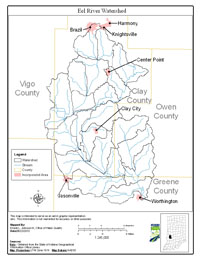Location
The Lower Eel River Watershed is located in west central Indiana, draining approximately 350 square miles in Clay, Owen, Greene, Sullivan and Vigo counties. Major streams included in the Total Maximum Daily Load (TMDL) report are Lower Eel River, Lick Creek, Birch Creek, Need Creek, Brush Creek, Connelly Ditch, and Wabash and Eel Canals.
History
A comprehensive survey of the Lower Eel River Watershed was conducted by Indiana Department of Environmental Management (IDEM) between July 23, 2001 and August 29, 2001. The primary cause of impairment is Escherichia coli bacteria (E. coli). Pollution sources in the watershed include nonpoint sources from agriculture and pastures, land application of manure and urban and rural run-off, as well as point sources from straight pipe discharges, home sewage treatment system disposal and combined sewer overflow outlets.
Pollutants Addressed
TMDLs for the Lower Eel River Watershed are established for E. coli and will address 21 impairments. Some of the recommended solutions to address the impairments include storm water controls, point source controls, manure management and habitat improvements.
Timeline
A kickoff TMDL meeting was held on August 2, 2004 at the First State Bank, community room, 502 Main Street (SR 59), Clay City, Indiana starting at 5:00 p.m.
A draft TMDL meeting was held on January 25, 2005 at the First Financial Bank (Formerly First State Bank), community room, 502 Main Street (SR 59), Clay City, Indiana starting at 5:00 p.m.
The 30-day public comment period for the draft Lower Eel River Watershed TMDL began on January 13, 2005 and ended on February 14, 2005.
U.S. EPA under Section 303(d) of the Clean Water Act approved the Lower Eel River Watershed TMDL report on March 28, 2005 for 21 impairments. TMDL reports identify and evaluate water quality problems in impaired water bodies and propose solutions to bring those waters into attainment with water quality standards.

